Bahamian vs Bermudan Community Comparison
COMPARE
Bahamian
Bermudan
Social Comparison
Social Comparison
Bahamians
Bermudans
919
SOCIAL INDEX
6.7/ 100
SOCIAL RATING
334th/ 347
SOCIAL RANK
2,838
SOCIAL INDEX
25.9/ 100
SOCIAL RATING
241st/ 347
SOCIAL RANK
Bermudan Integration in Bahamian Communities
The statistical analysis conducted on geographies consisting of 39,240,618 people shows a substantial positive correlation between the proportion of Bermudans within Bahamian communities in the United States with a correlation coefficient (R) of 0.560. On average, for every 1% (one percent) increase in Bahamians within a typical geography, there is an increase of 0.341% in Bermudans. To illustrate, in a geography comprising of 100,000 individuals, a rise of 1,000 Bahamians corresponds to an increase of 340.9 Bermudans.
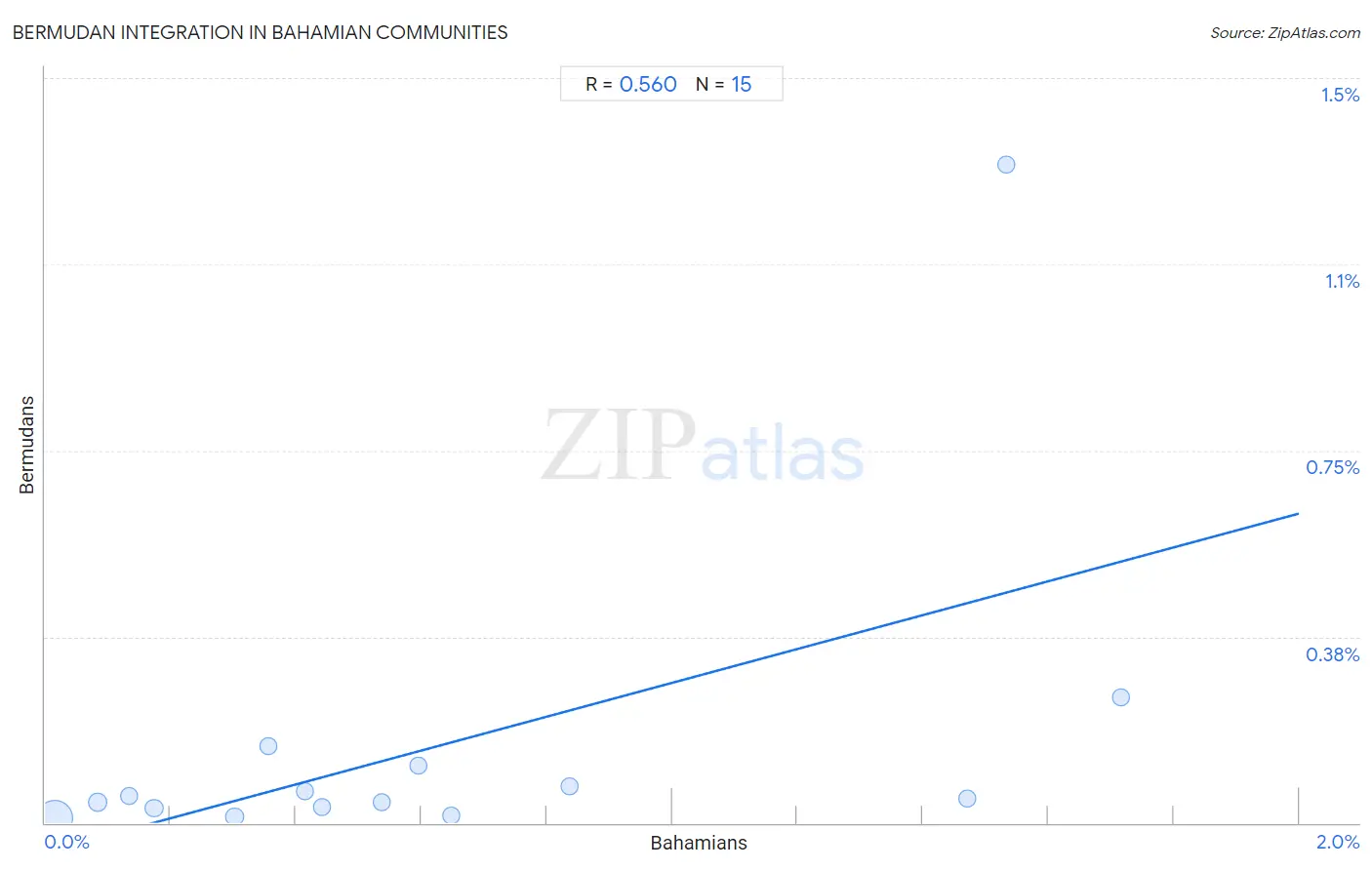
Bahamian vs Bermudan Income
When considering income, the most significant differences between Bahamian and Bermudan communities in the United States are seen in median family income ($82,631 compared to $97,577, a difference of 18.1%), per capita income ($36,427 compared to $42,911, a difference of 17.8%), and median male earnings ($44,756 compared to $52,465, a difference of 17.2%). Conversely, both communities are more comparable in terms of householder income under 25 years ($45,743 compared to $47,359, a difference of 3.5%), median female earnings ($35,125 compared to $39,418, a difference of 12.2%), and householder income over 65 years ($51,000 compared to $58,171, a difference of 14.1%).

| Income Metric | Bahamian | Bermudan |
| Per Capita Income | Tragic $36,427 | Fair $42,911 |
| Median Family Income | Tragic $82,631 | Tragic $97,577 |
| Median Household Income | Tragic $69,726 | Tragic $80,406 |
| Median Earnings | Tragic $39,735 | Fair $45,593 |
| Median Male Earnings | Tragic $44,756 | Poor $52,465 |
| Median Female Earnings | Tragic $35,125 | Fair $39,418 |
| Householder Age | Under 25 years | Tragic $45,743 | Tragic $47,359 |
| Householder Age | 25 - 44 years | Tragic $75,395 | Tragic $88,231 |
| Householder Age | 45 - 64 years | Tragic $81,369 | Tragic $94,197 |
| Householder Age | Over 65 years | Tragic $51,000 | Tragic $58,171 |
| Wage/Income Gap | Exceptional 20.2% | Exceptional 23.1% |
Bahamian vs Bermudan Poverty
When considering poverty, the most significant differences between Bahamian and Bermudan communities in the United States are seen in receiving food stamps (17.0% compared to 13.0%, a difference of 31.1%), married-couple family poverty (6.6% compared to 5.2%, a difference of 27.3%), and seniors poverty over the age of 75 (15.5% compared to 12.9%, a difference of 20.1%). Conversely, both communities are more comparable in terms of female poverty among 18-24 year olds (21.8% compared to 21.9%, a difference of 0.71%), single female poverty (22.7% compared to 22.3%, a difference of 1.8%), and single mother poverty (31.3% compared to 30.6%, a difference of 2.4%).
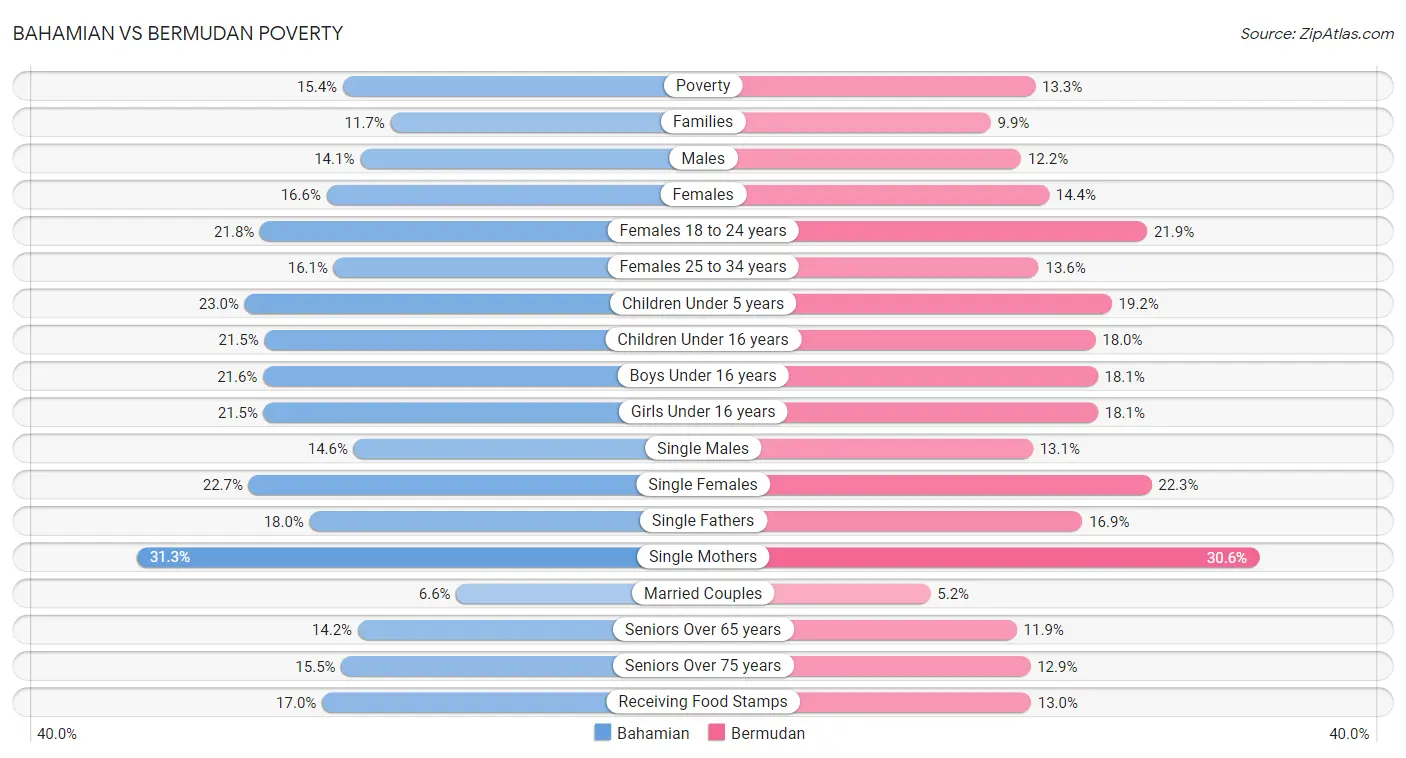
| Poverty Metric | Bahamian | Bermudan |
| Poverty | Tragic 15.4% | Tragic 13.3% |
| Families | Tragic 11.7% | Tragic 9.9% |
| Males | Tragic 14.1% | Tragic 12.2% |
| Females | Tragic 16.6% | Tragic 14.4% |
| Females 18 to 24 years | Tragic 21.8% | Tragic 21.9% |
| Females 25 to 34 years | Tragic 16.1% | Average 13.6% |
| Children Under 5 years | Tragic 23.0% | Tragic 19.2% |
| Children Under 16 years | Tragic 21.5% | Tragic 18.0% |
| Boys Under 16 years | Tragic 21.6% | Tragic 18.1% |
| Girls Under 16 years | Tragic 21.5% | Tragic 18.1% |
| Single Males | Tragic 14.6% | Poor 13.1% |
| Single Females | Tragic 22.7% | Tragic 22.3% |
| Single Fathers | Tragic 18.0% | Tragic 16.9% |
| Single Mothers | Tragic 31.3% | Tragic 30.6% |
| Married Couples | Tragic 6.6% | Average 5.2% |
| Seniors Over 65 years | Tragic 14.2% | Tragic 11.9% |
| Seniors Over 75 years | Tragic 15.5% | Tragic 12.9% |
| Receiving Food Stamps | Tragic 17.0% | Tragic 13.0% |
Bahamian vs Bermudan Unemployment
When considering unemployment, the most significant differences between Bahamian and Bermudan communities in the United States are seen in unemployment among seniors over 75 years (7.8% compared to 8.9%, a difference of 14.0%), unemployment among ages 30 to 34 years (6.6% compared to 5.8%, a difference of 13.5%), and unemployment among ages 16 to 19 years (19.8% compared to 17.6%, a difference of 12.5%). Conversely, both communities are more comparable in terms of male unemployment (5.9% compared to 5.9%, a difference of 0.33%), unemployment among youth under 25 years (13.1% compared to 13.0%, a difference of 0.60%), and unemployment among women with children under 6 years (8.7% compared to 8.7%, a difference of 0.73%).
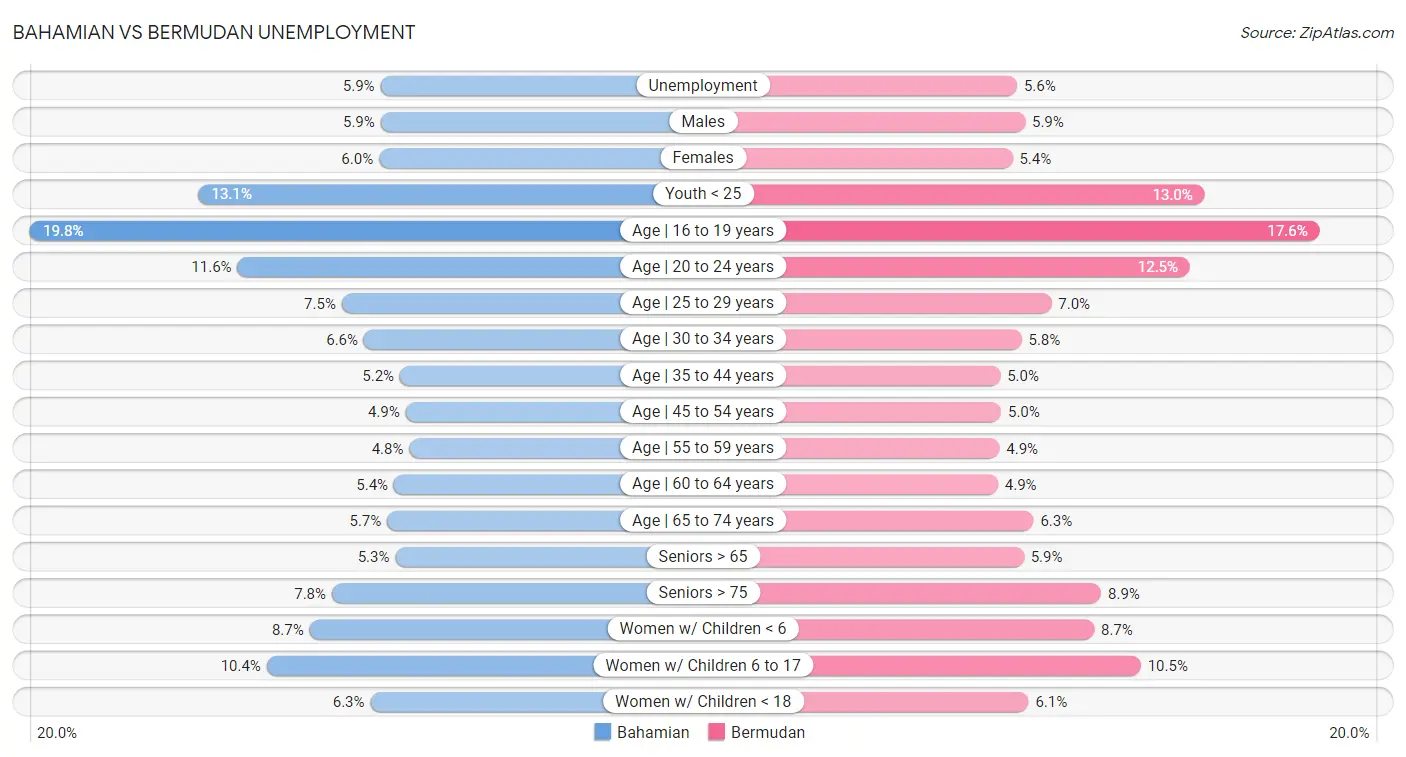
| Unemployment Metric | Bahamian | Bermudan |
| Unemployment | Tragic 5.9% | Tragic 5.6% |
| Males | Tragic 5.9% | Tragic 5.9% |
| Females | Tragic 6.0% | Tragic 5.4% |
| Youth < 25 | Tragic 13.1% | Tragic 13.0% |
| Age | 16 to 19 years | Tragic 19.8% | Average 17.6% |
| Age | 20 to 24 years | Tragic 11.6% | Tragic 12.5% |
| Age | 25 to 29 years | Tragic 7.5% | Tragic 7.0% |
| Age | 30 to 34 years | Tragic 6.6% | Tragic 5.8% |
| Age | 35 to 44 years | Tragic 5.2% | Tragic 5.0% |
| Age | 45 to 54 years | Tragic 4.9% | Tragic 5.0% |
| Age | 55 to 59 years | Good 4.8% | Poor 4.9% |
| Age | 60 to 64 years | Tragic 5.4% | Average 4.9% |
| Age | 65 to 74 years | Tragic 5.7% | Tragic 6.3% |
| Seniors > 65 | Tragic 5.3% | Tragic 5.9% |
| Seniors > 75 | Exceptional 7.8% | Poor 8.9% |
| Women w/ Children < 6 | Tragic 8.7% | Tragic 8.7% |
| Women w/ Children 6 to 17 | Tragic 10.4% | Tragic 10.5% |
| Women w/ Children < 18 | Tragic 6.3% | Tragic 6.1% |
Bahamian vs Bermudan Labor Participation
When considering labor participation, the most significant differences between Bahamian and Bermudan communities in the United States are seen in in labor force | age 16-19 (34.6% compared to 36.9%, a difference of 6.7%), in labor force | age > 16 (64.2% compared to 66.0%, a difference of 2.9%), and in labor force | age 25-29 (83.7% compared to 86.0%, a difference of 2.8%). Conversely, both communities are more comparable in terms of in labor force | age 35-44 (84.7% compared to 85.3%, a difference of 0.68%), in labor force | age 20-24 (73.3% compared to 74.1%, a difference of 1.2%), and in labor force | age 45-54 (82.2% compared to 83.1%, a difference of 1.2%).

| Labor Participation Metric | Bahamian | Bermudan |
| In Labor Force | Age > 16 | Tragic 64.2% | Exceptional 66.0% |
| In Labor Force | Age 20-64 | Tragic 78.4% | Exceptional 80.0% |
| In Labor Force | Age 16-19 | Tragic 34.6% | Good 36.9% |
| In Labor Force | Age 20-24 | Tragic 73.3% | Tragic 74.1% |
| In Labor Force | Age 25-29 | Tragic 83.7% | Exceptional 86.0% |
| In Labor Force | Age 30-34 | Tragic 83.9% | Exceptional 85.9% |
| In Labor Force | Age 35-44 | Exceptional 84.7% | Exceptional 85.3% |
| In Labor Force | Age 45-54 | Tragic 82.2% | Excellent 83.1% |
Bahamian vs Bermudan Family Structure
When considering family structure, the most significant differences between Bahamian and Bermudan communities in the United States are seen in single father households (2.5% compared to 2.1%, a difference of 17.3%), births to unmarried women (40.8% compared to 35.5%, a difference of 14.7%), and single mother households (8.3% compared to 7.3%, a difference of 13.4%). Conversely, both communities are more comparable in terms of family households with children (26.5% compared to 26.3%, a difference of 0.61%), family households (63.3% compared to 62.2%, a difference of 1.9%), and average family size (3.28 compared to 3.20, a difference of 2.5%).

| Family Structure Metric | Bahamian | Bermudan |
| Family Households | Tragic 63.3% | Tragic 62.2% |
| Family Households with Children | Tragic 26.5% | Tragic 26.3% |
| Married-couple Households | Tragic 40.5% | Tragic 42.4% |
| Average Family Size | Exceptional 3.28 | Poor 3.20 |
| Single Father Households | Tragic 2.5% | Exceptional 2.1% |
| Single Mother Households | Tragic 8.3% | Tragic 7.3% |
| Currently Married | Tragic 41.2% | Tragic 43.5% |
| Divorced or Separated | Tragic 14.2% | Tragic 12.7% |
| Births to Unmarried Women | Tragic 40.8% | Tragic 35.5% |
Bahamian vs Bermudan Vehicle Availability
When considering vehicle availability, the most significant differences between Bahamian and Bermudan communities in the United States are seen in no vehicles in household (9.9% compared to 12.8%, a difference of 29.2%), 4 or more vehicles in household (5.1% compared to 5.6%, a difference of 10.6%), and 3 or more vehicles in household (16.9% compared to 17.8%, a difference of 4.8%). Conversely, both communities are more comparable in terms of 2 or more vehicles in household (51.5% compared to 50.6%, a difference of 1.8%), 1 or more vehicles in household (90.2% compared to 87.5%, a difference of 3.0%), and 3 or more vehicles in household (16.9% compared to 17.8%, a difference of 4.8%).

| Vehicle Availability Metric | Bahamian | Bermudan |
| No Vehicles Available | Excellent 9.9% | Tragic 12.8% |
| 1+ Vehicles Available | Excellent 90.2% | Tragic 87.5% |
| 2+ Vehicles Available | Tragic 51.5% | Tragic 50.6% |
| 3+ Vehicles Available | Tragic 16.9% | Tragic 17.8% |
| 4+ Vehicles Available | Tragic 5.1% | Tragic 5.6% |
Bahamian vs Bermudan Education Level
When considering education level, the most significant differences between Bahamian and Bermudan communities in the United States are seen in doctorate degree (1.5% compared to 1.8%, a difference of 26.1%), master's degree (12.4% compared to 15.4%, a difference of 24.4%), and professional degree (3.7% compared to 4.4%, a difference of 18.5%). Conversely, both communities are more comparable in terms of nursery school (97.8% compared to 98.0%, a difference of 0.20%), kindergarten (97.8% compared to 98.0%, a difference of 0.22%), and 1st grade (97.7% compared to 97.9%, a difference of 0.22%).
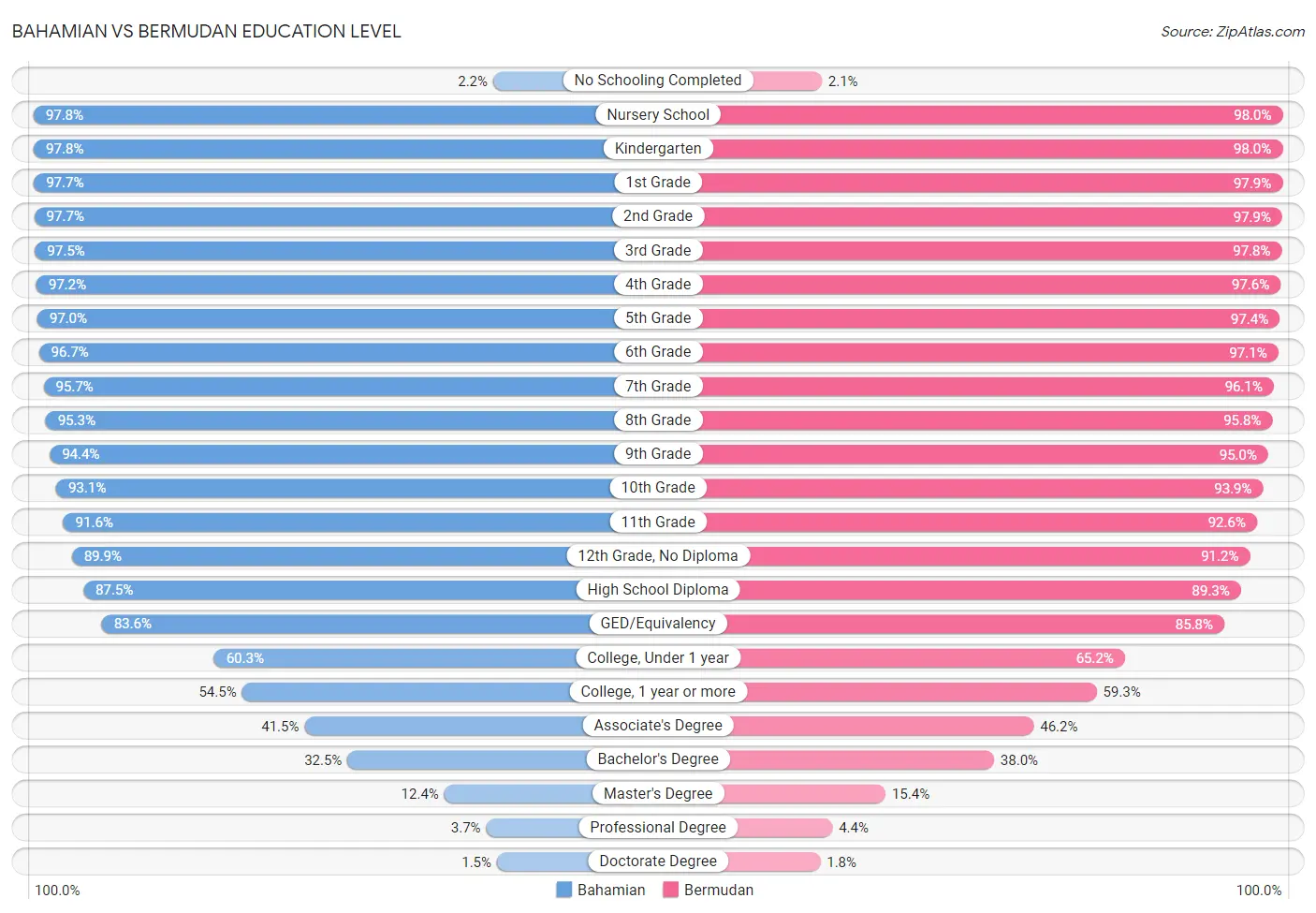
| Education Level Metric | Bahamian | Bermudan |
| No Schooling Completed | Poor 2.2% | Fair 2.1% |
| Nursery School | Tragic 97.8% | Average 98.0% |
| Kindergarten | Tragic 97.8% | Average 98.0% |
| 1st Grade | Tragic 97.7% | Average 97.9% |
| 2nd Grade | Tragic 97.7% | Average 97.9% |
| 3rd Grade | Tragic 97.5% | Good 97.8% |
| 4th Grade | Tragic 97.2% | Good 97.6% |
| 5th Grade | Tragic 97.0% | Average 97.4% |
| 6th Grade | Tragic 96.7% | Average 97.1% |
| 7th Grade | Poor 95.7% | Good 96.1% |
| 8th Grade | Tragic 95.3% | Good 95.8% |
| 9th Grade | Tragic 94.4% | Good 95.0% |
| 10th Grade | Tragic 93.1% | Good 93.9% |
| 11th Grade | Tragic 91.6% | Good 92.6% |
| 12th Grade, No Diploma | Tragic 89.9% | Average 91.2% |
| High School Diploma | Tragic 87.5% | Good 89.3% |
| GED/Equivalency | Tragic 83.6% | Average 85.8% |
| College, Under 1 year | Tragic 60.3% | Average 65.2% |
| College, 1 year or more | Tragic 54.5% | Average 59.3% |
| Associate's Degree | Tragic 41.5% | Average 46.2% |
| Bachelor's Degree | Tragic 32.5% | Average 38.0% |
| Master's Degree | Tragic 12.4% | Good 15.4% |
| Professional Degree | Tragic 3.7% | Average 4.4% |
| Doctorate Degree | Tragic 1.5% | Average 1.8% |
Bahamian vs Bermudan Disability
When considering disability, the most significant differences between Bahamian and Bermudan communities in the United States are seen in disability age 18 to 34 (6.6% compared to 7.3%, a difference of 11.7%), vision disability (2.4% compared to 2.2%, a difference of 8.7%), and disability age under 5 (1.3% compared to 1.4%, a difference of 4.4%). Conversely, both communities are more comparable in terms of self-care disability (2.6% compared to 2.6%, a difference of 0.070%), disability age 5 to 17 (6.3% compared to 6.4%, a difference of 0.55%), and disability (12.2% compared to 12.3%, a difference of 0.78%).
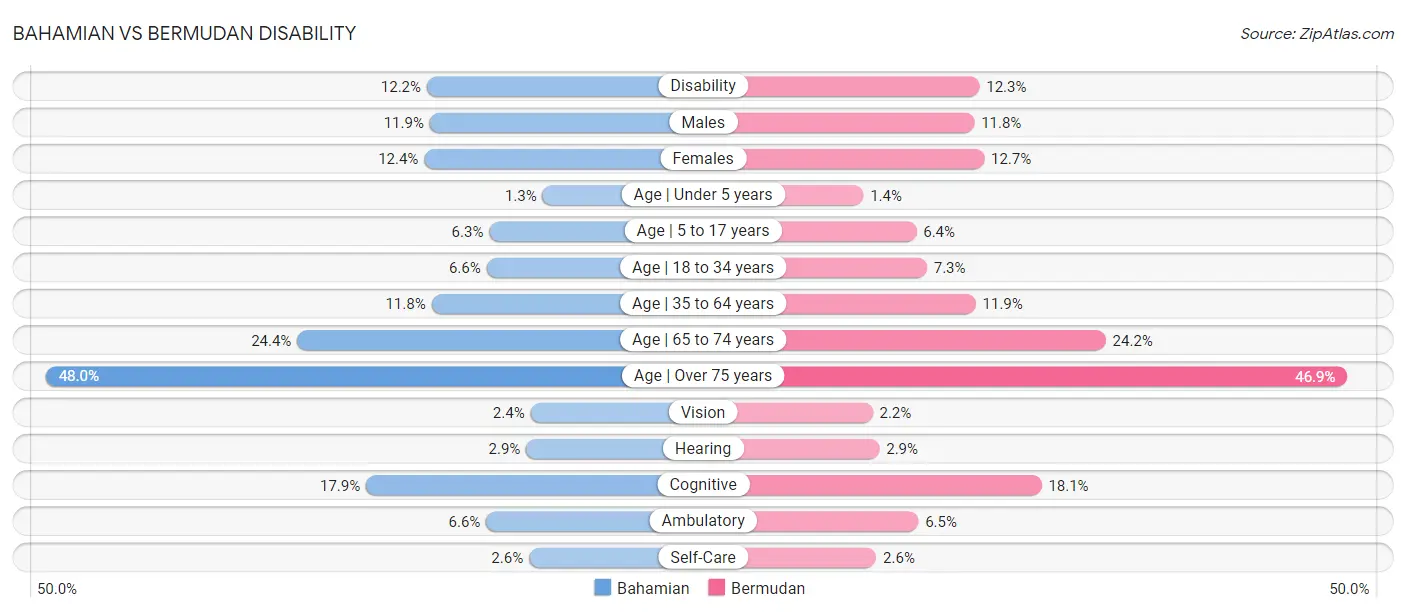
| Disability Metric | Bahamian | Bermudan |
| Disability | Tragic 12.2% | Tragic 12.3% |
| Males | Tragic 11.9% | Tragic 11.8% |
| Females | Poor 12.4% | Tragic 12.7% |
| Age | Under 5 years | Tragic 1.3% | Tragic 1.4% |
| Age | 5 to 17 years | Tragic 6.3% | Tragic 6.4% |
| Age | 18 to 34 years | Average 6.6% | Tragic 7.3% |
| Age | 35 to 64 years | Poor 11.8% | Tragic 11.9% |
| Age | 65 to 74 years | Tragic 24.4% | Tragic 24.2% |
| Age | Over 75 years | Tragic 48.0% | Excellent 46.9% |
| Vision | Tragic 2.4% | Tragic 2.2% |
| Hearing | Excellent 2.9% | Excellent 2.9% |
| Cognitive | Tragic 17.9% | Tragic 18.1% |
| Ambulatory | Tragic 6.6% | Tragic 6.5% |
| Self-Care | Tragic 2.6% | Tragic 2.6% |